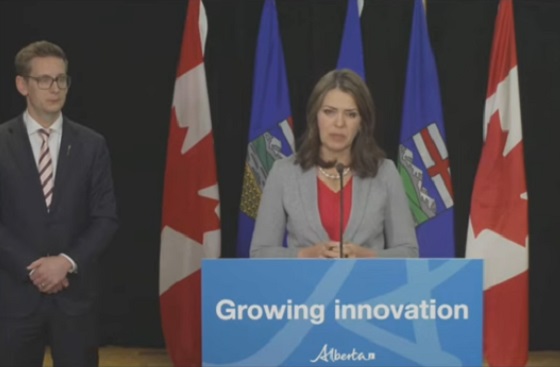Alberta
Alberta laying out the welcome mat for AI Data Centres

Fueling innovation through AI data centre attraction
Alberta’s government is aiming for Alberta to become North America’s destination of choice for Artificial Intelligence (AI) data centre investment.
The AI data centre attraction strategy identifies three pillars that create the foundation of Alberta’s work to position itself as a competitive player in the global AI landscape: power capacity, sustainable cooling and economic diversification. In each of these strategic areas, there are policy and regulatory levers required in addition to other steps Alberta’s government is taking to ensure Alberta is the most attractive and competitive destination for this emerging sector. The entire approach prioritizes competitive advantages, economic integration, market stability and keeping utilities reliable and affordable.
“Artificial intelligence is behind all the newest technologies we rely on to make our lives better, simpler, safer. There’s incredible opportunity around artificial intelligence and we are unafraid to dream big. This strategy will position Alberta as the place to invest and build AI data centres, further building on our reputation as a province with no limit to innovation and opportunity.”
The world’s largest AI companies are in search of opportunities to build and energize their data centres. Alberta, with its abundant natural gas supply and world-class power industry, is highly attractive to AI data centre projects. The province’s unique competitive power market opens the door to many opportunities for AI companies to partner with Alberta’s talented and experienced electricity sector. The sector has decades of experience in finding innovative solutions to meet industry’s power needs while maintaining a balance of affordability and reliability in a system that Albertans count on.
AI data centres generate a lot of heat and require cooling. The strategy encourages operators to determine the cooling technology best suited for their needs, water license availability and regional and project circumstance. Additionally, Alberta’s climate offers significant advantages for AI data centres because of the province’s cold winters, which would reduce the need for artificial cooling systems.
Alberta’s government seeks to ensure Albertans benefit from AI data centres and is committed to ensuring economic growth and shared prosperity while ensuring Alberta continues to have the lowest taxes in Canada and is competitive across North America.
“Alberta is uniquely positioned to capture the AI data center opportunity, leveraging our vast natural gas resources and pro-business environment to create thousands of high-quality jobs and attract billions in investment. This strategy is not just about building infrastructure; it’s about fostering innovation and establishing Alberta as a hub for high-tech industries, driving economic growth and supporting critical public services like healthcare and education.”
Alberta is committed to fostering innovation and ensuring technology development aligns with industry needs. The strategy was developed after extensive consultation with organizations and businesses in the AI space and market participants.
“For AI companies to build and scale in Alberta, they need access to computing power. Data centers are economic growth engines that provide the computing power AI companies need to develop and deploy their innovations. grow their companies and stimulate the local economies. Beyond its natural advantages, Alberta boasts a robust AI ecosystem anchored by world-class research and talent. Many of the algorithms the world’s data centers are running on have been pioneered by Amii researchers right here in Alberta. The opportunity for those companies to be close to the source of some of the leading AI research gives them a competitive advantage in being at the forefront of what is coming next.”
Quick facts
- Over the past several months, Technology and Innovation met with AI data centre builders and operators, power generators, natural resource sector participants, telecommunications companies and municipalities actively pursuing AI data centres.
- AI data centre market size is anticipated to more than double by 2030 to more than $820 billion. (P&S Market Research)
- Alberta Electricity System Operator (AESO) has 12 data centre projects on their project list totalling 6,455 MW of load.
- Most of the power demand on the AESO project list is from data centers.
- Currently there is about 1,000 MW of additional dispatchable generation over Alberta’s current needs. This amount is dynamic and may change due to factors such as generation retirements, outages, derates, or new additions.
Related information
Alberta
CPP another example of Albertans’ outsized contribution to Canada

From the Fraser Institute
By Tegan Hill
Amid the economic uncertainty fuelled by Trump’s trade war, its perhaps more important than ever to understand Alberta’s crucial role in the federation and its outsized contribution to programs such as the Canada Pension Plan (CPP).
From 1981 to 2022, Albertan’s net contribution to the CPP—meaning the amount Albertans paid into the program over and above what retirees in Alberta received in CPP payments—was $53.6 billion. In 2022 (the latest year of available data), Albertans’ net contribution to the CPP was $3.0 billion.
During that same period (1981 to 2022), British Columbia was the only other province where residents paid more into the CPP than retirees received in benefits—and Alberta’s contribution was six times greater than B.C.’s contribution. Put differently, residents in seven out of the nine provinces that participate in the CPP (Quebec has its own plan) receive more back in benefits than they contribute to the program.
Albertans pay an outsized contribution to federal and national programs, including the CPP because of the province’s relatively high rates of employment, higher average incomes and younger population (i.e. more workers pay into the CPP and less retirees take from it).
Put simply, Albertan workers have been helping fund the retirement of Canadians from coast to coast for decades, and without Alberta, the CPP would look much different.
How different?
If Alberta withdrew from the CPP and established its own standalone provincial pension plan, Alberta workers would receive the same retirement benefits but at a lower cost (i.e. lower CPP contribution rate deducted from our paycheques) than other Canadians, while the contribution rate—essentially the CPP tax rate—to fund the program would likely need to increase for the rest of the country to maintain the same benefits.
And given current demographic projections, immigration patterns and Alberta’s long history of leading the provinces in economic growth, Albertan workers will likely continue to pay more into the CPP than Albertan retirees get back from it.
Therefore, considering Alberta’s crucial role in national programs, the next federal government—whoever that may be—should undo and prevent policies that negatively impact the province and Albertans ability to contribute to Canada. Think of Bill C-69 (which imposes complex, uncertain and onerous review requirements on major energy projects), Bill C-48 (which bans large oil tankers off B.C.’s northern coast and limits access to Asian markets), an arbitrary cap on oil and gas emissions, numerous other “net-zero” targets, and so on.
Canada faces serious economic challenges, including a trade war with the United States. In times like this, it’s important to remember Alberta’s crucial role in the federation and the outsized contributions of Alberta workers to the wellbeing of Canadians across the country.
Alberta
Made in Alberta! Province makes it easier to support local products with Buy Local program

Show your Alberta side. Buy Local. |
When the going gets tough, Albertans stick together. That’s why Alberta’s government is launching a new campaign to benefit hard-working Albertans.
Global uncertainty is threatening the livelihoods of hard-working Alberta farmers, ranchers, processors and their families. The ‘Buy Local’ campaign, recently launched by Alberta’s government, encourages consumers to eat, drink and buy local to show our unified support for the province’s agriculture and food industry.
The government’s ‘Buy Local’ campaign encourages consumers to buy products from Alberta’s hard-working farmers, ranchers and food processors that produce safe, nutritious food for Albertans, Canadians and the world.
“It’s time to let these hard-working Albertans know we have their back. Now, more than ever, we need to shop local and buy made-in-Alberta products. The next time you are grocery shopping or go out for dinner or a drink with your friends or family, support local to demonstrate your Alberta pride. We are pleased tariffs don’t impact the ag industry right now and will keep advocating for our ag industry.”
Alberta’s government supports consumer choice. We are providing tools to help folks easily identify Alberta- and Canadian-made foods and products. Choosing local products keeps Albertans’ hard-earned dollars in our province. Whether it is farm-fresh vegetables, potatoes, honey, craft beer, frozen food or our world-renowned beef, Alberta has an abundance of fresh foods produced right on our doorstep.
Quick facts
- This summer, Albertans can support local at more than 150 farmers’ markets across the province and meet the folks who make, bake and grow our food.
- In March 2023, the Alberta government launched the ‘Made in Alberta’ voluntary food and beverage labelling program to support local agriculture and food sectors.
- Through direct connections with processors, the program has created the momentum to continue expanding consumer awareness about the ‘Made in Alberta’ label to help shoppers quickly identify foods and beverages produced in our province.
- Made in Alberta product catalogue website
Related information
-

 International2 days ago
International2 days agoPope Francis has died aged 88
-

 International2 days ago
International2 days agoJD Vance was one of the last people to meet Pope Francis
-

 2025 Federal Election1 day ago
2025 Federal Election1 day agoOttawa Confirms China interfering with 2025 federal election: Beijing Seeks to Block Joe Tay’s Election
-

 Business2 days ago
Business2 days agoCanada Urgently Needs A Watchdog For Government Waste
-

 2025 Federal Election16 hours ago
2025 Federal Election16 hours agoBREAKING: THE FEDERAL BRIEF THAT SHOULD SINK CARNEY
-

 International2 days ago
International2 days agoPope Francis Dies on Day after Easter
-

 COVID-191 day ago
COVID-191 day agoNearly Half of “COVID-19 Deaths” Were Not Due to COVID-19 – Scientific Reports Journal
-

 2025 Federal Election1 day ago
2025 Federal Election1 day agoHow Canada’s Mainstream Media Lost the Public Trust






